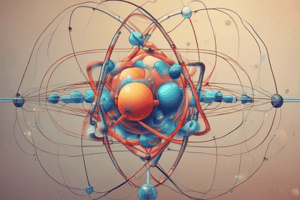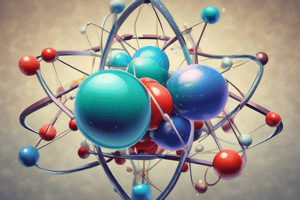Podcast
Questions and Answers
What is defined as the total number of protons and neutrons in an atom?
What is defined as the total number of protons and neutrons in an atom?
- Mass Number (correct)
- Isotope
- Atomic Number
- Atomic Mass
Who is credited with the discovery of neutrons?
Who is credited with the discovery of neutrons?
- James Chadwick (correct)
- Rutherford
- JJ Thompson
- Democritus
Which statement accurately describes isotopes?
Which statement accurately describes isotopes?
- Atoms of different elements with the same mass
- Atoms of the same element with a different number of neutrons (correct)
- Atoms with the same number of protons and electrons
- Atoms with the same atomic number but different charges
What is the atomic number of an element?
What is the atomic number of an element?
Which scientist conducted the oil drop experiment to discover the charge of an electron?
Which scientist conducted the oil drop experiment to discover the charge of an electron?
Which statement best represents Dalton's atomic theory?
Which statement best represents Dalton's atomic theory?
What distinguishes an isotope from regular atoms of the same element?
What distinguishes an isotope from regular atoms of the same element?
What is the primary discovery made by Rutherford in his gold foil experiment?
What is the primary discovery made by Rutherford in his gold foil experiment?
Which of the following definitions correctly describes atomic mass?
Which of the following definitions correctly describes atomic mass?
Which scientist is credited with discovering that atoms are indivisible particles?
Which scientist is credited with discovering that atoms are indivisible particles?
Flashcards are hidden until you start studying
Study Notes
Dalton’s Atomic Theory
- Proposed by John Dalton in the early 19th century
- All matter is composed of atoms, which are the smallest units of an element
- Atoms of the same element are identical in mass and properties, while atoms of different elements have different properties
- Chemical reactions involve rearranging atoms in whole number ratios to form compounds
- Atoms are indivisible in chemical reactions
Key Scientists and Discoveries
- Democritus (Ancient Greek philosopher) first proposed the idea of atoms, although his theory was not based on scientific evidence.
- John Dalton (English chemist) developed the first scientific atomic theory, based on experimental observations.
- J.J. Thomson (English physicist) discovered the electron through his work on cathode rays.
- Robert Millikan (American physicist) determined the charge of the electron through his oil drop experiment.
- Ernest Rutherford (New Zealand physicist) conducted the gold foil experiment, which led to the discovery of the nucleus and the proton.
- James Chadwick (English physicist) discovered the neutron.
Atomic Structure
- Atomic Number: The number of protons in an atom's nucleus. It defines the element.
- Mass Number: The sum of protons and neutrons in an atom's nucleus.
- Atomic Mass: The average mass of all isotopes of an element, taking into account their relative abundances.
- Isotopes: Atoms of the same element that have the same number of protons (atomic number) but different numbers of neutrons. For example, Carbon-12 and Carbon-14 are isotopes of carbon.
Studying That Suits You
Use AI to generate personalized quizzes and flashcards to suit your learning preferences.




